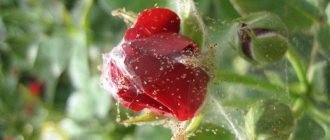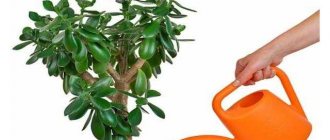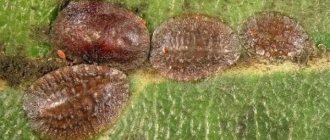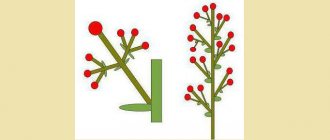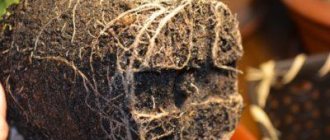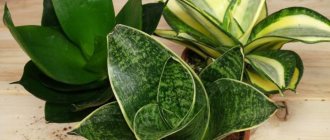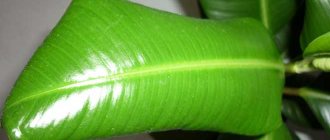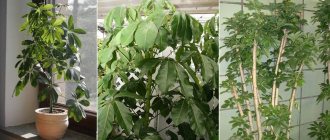Harmful insects and their control
Thanks to its unique aroma, pelargonium repels most pests. However, a weakened plant is not resistant to damage by certain species:
- Root mealybug .
It feeds on roots and reproduces well in moist environments. To get rid of the pest, you should remove the pelargonium from the pot, cut off all affected roots, and treat it with Vidat or Tekta. Then you need to sterilize the pot and fresh soil by treating them with a pink solution of potassium permanganate. Plant the plant in the ground and water it. - The mealybug is an insect 2-10 mm in size that feeds on plant sap. It is clearly distinguishable visually, leaves a white cottony coating on the shoots and a sticky secretion - honeydew, in which black sooty fungus settles within 1-2 days. It is destroyed when watered with Aktara, Actellik, Mospilan or Confidor.
- Aphids are small insects up to 2 mm in size. They appear on pelargonium in case of infection from another plant or excessive watering. The leaves of the affected plant curl and become sticky. Aphids die when sprayed with biological preparations Fitoverm, Biostop or Leptotsid.
- Spider mites are insects up to 1 mm long that feed on plant sap. Color ranges from pale gray to bright red. Often invisible on plants. Entangles shoots with a thin, almost transparent web. Destroyed by spraying with Fitoverm or a strong soap solution. In this case, the treated plant should be covered with film and left for a day to completely destroy the pests.
- The whitefly is a small butterfly that lives on the underside of pelargonium leaves and feeds on their juice. To destroy, you should spray the plant with Aktara or Confidor.
- Caterpillars are the larvae of various butterflies that cause harm by gnawing on leaves and young shoots. Treatment with biological preparations Fitoverm, Biostop, Leptotsid will allow you to get rid of pests for a long time. Caterpillars can also be collected manually.
You can learn more about pests of pelargonium in this video:
Typical diseases of geranium
Diseases of geranium can be noticed by yellowed and drying leaves, the appearance of rust, spotting, swelling, lack of flowering, bacterial, fungal damage, root rot and viral infections. Let us consider the main diseases and methods of their treatment in more detail. If there are violations during care, geranium (pelargonium) appears:
Yellowness on leaves
We need to find out why geranium leaves lighten, turn yellow and wither, and then take resuscitation measures. This may be due to a lack of fresh air in the room, drafts, excessive watering or moisture deficiency, excess nitrogen in the soil or lack of micronutrients. The parameters of the pot also play an important role in the life of the plant. A narrow pot aggravates the development of the root system, so not only the leaves, but also other parts of the geranium die off. But if, with normal care, the leaves of a geranium turn pale, the reason can be determined by the development of the root system: if root rot has appeared or a mealybug is parasitizing, the leaves will turn yellow and dry out.
It is important to know! If the plant has just been replanted, and the leaves at the bottom of the bush begin to turn yellow, then this is considered a side effect. The yellow parts are removed, and the geranium continues its development.
No flowering
Geraniums are grown for their spectacular, large and beautiful flowers. It stops blooming in the presence of causative factors:
- insufficient lighting;
- low temperature;
- too large a container: roots grow intensively, flowering slows down or is absent;
- excess fertilizer;
- lack of nutrition in the soil;
- thickening of green mass, in the absence or insufficient pruning;
- root rot and scale insects.
To resuscitate a plant, you need to eliminate all negative factors and cure the root system.
Dried leaves
Why do geranium leaves have small leaves and dry edges: there is not enough moisture in the soil. When dry:
- flower - a fungal disease has appeared;
- leaves and the appearance of wet areas on the stems - stem rot has begun;
- lower leaves along the edges - there is not enough nutrition or old leaves are dying.
Fungi are eliminated by treating them twice with Fitosporin (a break of 7 days between treatments) and watering the plant with 5% Bordeaux mixture.
Botrytis mushroom
The fungal disease appears on the plant as gray spots, then brown and fluff; all parts of the bush wither when exposed to excessive moisture. How to treat geranium if the leaves are brown, rot and fall off:
- clear the soil of weeds and dry plant fragments;
- loosen the soil so that it absorbs water well, passes excess through drainage and dries out;
- remove and destroy parts of the bush affected by the fungus;
- treat geranium with fungicides.
Recommendation! The soil absorbs water well, allows it to pass through, and dries out during the morning spill no later than 11 o’clock.
Root rot
The activity of the fungus leads to yellowing of the leaf plates. Later, brown and even black spots appear on the leaves of indoor geranium. On the plant itself you can notice a light coating in the form of a cobweb due to advanced root rot and/or root worms. To get rid of rot, the following work is carried out:
- loosen the soil;
- exclude fertilizers with nitrogen;
- remove and destroy diseased stems with leaves;
- apply fungicides to waterlogged soils;
- for root bugs: cut off parts of the affected roots with a knife, and place healthy ones in hot water, dry them and sprinkle them with charcoal flour, then transplant the bush into new, sterile soil;
- for mealybugs: pelargonium is isolated and the parasites are removed by hand and sprayed with a soap-alcohol mixture. In advanced stages, they are treated with insecticides: Actra, Actellik or Fufanon.
If root rot has slightly affected the roots, the bush should be removed from the pot, washed well, then treated with such agents as Hom, Oxychom, Fundazol or Pervikur.
Leaf rust
Why do the leaves of indoor geranium turn red and pale green spots with red dots and rusty-yellow zones form? Fungal spores collect in pads and when they open, they are carried by gusts of wind from an open window or drafts. In the final stages, the flower rots and turns black, withers and dies. The plant can be revived only in the initial stages, before blackening appears. For this:
- remove weeds and dead parts on the bush;
- carry out bottom watering;
- treated with fungicides.
Bacterial diseases
As a result of their vital activity, microbes leave dark yellow, brown and black triangular spots on the leaves, which leads to drying and wilting of the plant. To eliminate bacteria, you must:
- clean the soil or even replace it with quality soil;
- water pelargonium in the morning;
- treat with fungicides;
- for pelargonium - use fungicides; for street geranium - there is no need to use them.
Viral diseases
Viral diseases of ivy-leaved pelargonium and other species cause cessation of stem growth and the formation of brown-purple round spots on the leaf blades. Viral infections are treated like bacterial ones, but at the same time they fight insects that carry pathogens.
spotting
Bubbles and spots under the leaf blade are called Alternaria blight. After yellowing, the leaf gradually fades and falls off. Spots in the form of pale sunken areas, then gray and brown, also appear with cercospora. Such lesions tend to rise in the center. For the purpose of resuscitation, diseased leaves are removed, shoots are thinned out and treated with fungicides.
Edema
How to save geraniums from wilting due to swelling: light green, then brown bladderwort on the leaves, filled with liquid:
- reduce the frequency and dose of watering the flower to avoid excess moisture;
- increase air and soil temperatures.
If the pot is over-moistened or kept without drainage, or if there is an excess or lack of microelements in fertilizers and light, pelargonium (geranium) may also die.
Rules for home care for prevention
Disease prevention is mandatory and consists of the following:
- Disinfection of soil before planting . It is carried out by heating in the oven at a temperature of +80+1000C for 10 minutes, watering with a pink solution of potassium permanganate or biological preparations Fitosporin-M or Fitodoctor.
- Timely feeding . During the period of growing green mass, use nitrogen fertilizers, and later - potassium and phosphorus fertilizers.
- Loosening the soil . This is carried out at least once every 2 weeks to prevent water stagnation and saturate the soil with oxygen.
- Compliance with the watering regime . Pelargonium does not tolerate stagnation of moisture or drying out of the soil.
- Annual replacement of soil in the pot . This is done to prevent stagnation and provide the plant with nutrients.
Pelargonium has strong immunity to bacterial diseases and is resistant to damage by pests. As additional protection, it is necessary to carry out preventive measures, which consist of the usual adherence to the rules of agricultural technology.
Pot for pelargonium
Periodically, the plant requires transplanting into a new pot, several cm larger in diameter than the previous one.
Pelargoniums of different types need pots of different sizes:
- Zonal pelargoniums – 1-1.8 l
- Tall varieties - 1.5-2.5 l
- Dwarf, miniature – 0.5-1 l
Dwarf varieties differ from others in having a small root system; it is quite weak, so such pelargoniums do not like replanting and do not tolerate transplantation well. Some varieties of miniature pelargoniums, after being transplanted into a large pot, grow large and lose their miniature size.
How to protect a plant from diseases
A properly organized plant protection system from pests and diseases includes not only effective treatment methods, but also preventive measures. It is necessary to regularly inspect the plants, sterilize the soil with potassium permanganate or boiling water before planting, and remove dried parts of the plant. These simple steps can prevent the appearance of pests and eliminate sources of infection.
The mallow plant is more susceptible to various diseases than other garden flowers. Pests also love to attack it. To reduce the frequency of problems and reduce the damage from them, you need to maintain the necessary conditions for the healthy development of the flower and regularly carry out disease prevention.
Modifications for other reasons
Unfortunately, sometimes unpleasant modifications that are not associated with diseases can occur with pelargonium. If your home flower:
- The lower leaves turn yellow at the edges - feed the plant generously.
- The leaves take on a reddish-red color - make sure that the plant is warm at night, add magnesium fertilizer to the soil.
- There are no buds - the plant receives either too much fertilizer or too little sunlight (perhaps the air in the room is too warm).
- For some reason, the buds are drying out - limit the amount of water entering the soil, provide drier air in the room.
- The plant looks spindly - improve the lighting in the room.
Rust
The disease manifests itself with the appearance of clearly defined yellow spots on the upper part of the leaf. On the reverse side of the leaf, brown pustules form (in the same places where the upper spots are located). As the disease progresses, the leaves turn yellow, dry out and fall off. Geranium does not bloom.
Why does this disease occur? It is transmitted through infected plants both by air and by water. If care is improper (too warm and too humid), this disease causes severe damage to large plantings.
As soon as the first signs of rust appear, it is necessary to reduce the level of air humidity, stop spraying the plants, and remove infected leaves. It is also necessary to treat with systemic fungicides in a timely manner (Topaz is excellent).
Folk recipes
- Mechanical method. The simplest and at the same time difficult way is to simply remove the caterpillars from the bush. This method works if there are not too many individuals. However, the difficulty lies in the fact that it is not always possible to find the pests themselves, or to find them, but not all of them. In any case, this method works in conjunction with others.
- Soap solution. It helps not only against caterpillars, but also against other pests. The leaves and stem of geranium are wiped with soapy water or sprayed.
- Apples. The apple should be cut into slices and placed overnight on the ground around the plant. In the morning you will see pests feasting on apple pieces.
- Paper. You need to lay white paper under the plant and shake it, green caterpillars get on the leaf, then you can simply destroy them. But this method is not reliable enough, because not all individuals can fall.
- Hot shower. Pests cannot tolerate hot showers, so you can wash the geranium leaves with hot water. The insects will be washed away, but it will not harm the plant.
Rhizoctonia rot
Dark spots form on the stems at the bottom. They have a depressed structure and stretch up a maximum of twenty-five centimeters. Geranium does not bloom. Subsequently, the leaves turn yellow and the plants wither. Infection occurs through the soil.
Factors provoking the development of the disease:
- excessive fertilizer content in the soil;
- increased air temperature (especially in winter, during the heating season);
- excessive moisture of the substrate;
- insufficient ventilation, little light.
All of the above can be characterized by one concept - improper care and maintenance. What needs to be done to defeat this disease and grow a healthy plant? You need to use only high-quality soil. When the first signs are detected, you should stop watering and treat with the following preparations - Vitaros, Fundazol, Rovral.
